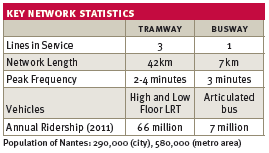Steer Davies Gleave has worked with many clients internationally to plan, design and evaluate Light Rail Transit (LRT) and Bus Rapid Transit (BRT) projects. Although much is known about the differences in BRT and LRT technologies, less is known about how passengers perceive them and their preferences.
In order to understand these passenger perceptions better and provide our clients with greater insight on this subject, we have been carrying out internal Research and Innovation (R&I) projects to develop our knowledge in this area. Nantes in France was considered a good case study because of its relatively modern LRT and BRT networks. Work included two types of research:
- Focus group questionnaires exploring passenger use and experience of both modes
- Stated Preference surveys offering passenger travel choices in which the characteristics of each system were traded off against each other.
We found that passengers expressed high levels of satisfaction with both systems, with an overall preference for LRT over BRT.
However, analysis of individual trip components revealed that better LRT network coverage was the main reason behind this preference. BRT performed better on comfort and security, and once these technology-neutral factors were taken out of the equation, the residual preference was slightly in favor of BRT.
These findings are specific to Nantes, but it suggests that from the passenger’s perspective there is no reason to suppose that BRT is innately inferior to LRT and a well-designed and operated BRT system can be at least as attractive to passengers as LRT. Therefore, in making a choice between BRT and LRT we should consider broader transportation planning factors including capacity requirements, network integration and affordability.
LRT has been widely used as a catalyst for urban growth. While many North American cities are growing rapidly, the population in Nantes is relatively stable, and therefore the primary purpose of investing in rapid transit/fixed guideway projects has been to improve transportation efficiency, reduce traffic congestion and provide opportunities for urban realm improvements. Nevertheless, a representative from Samoa (a developer in Nantes) points out that LRT is ‘the spine of urban planning’, with its permanent nature offering a better guarantee on real estate pricing and future local investment, and is therefore more attractive to developers.
